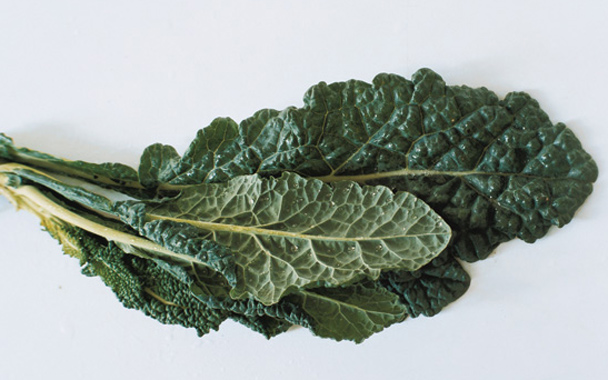For about the last month I’ve been working my way through the cool-weather cooking greens—bitter escarole and crunchy kale one week, sweet collards and hot red mustard greens the next. The greens are magnificent, one of the best things about cooking in early fall. Keith Stewart stacks eight or ten different kinds in rows under his tent at the Greenmarket, and the sight got me wondering about how much biological diversity all that abundance represents. An hour spent with two of my favorite references, Elizabeth Schneider’s Vegetables from Amaranth to Zucchini and Harold McGee’s On Food and Cooking, gave me some answers, along with a few new thoughts about how to spend my winter cooking.
I’ve known for a while that collards, cabbage, and kale, along with broccoli, kohlrabi, and cauliflower, are all varieties of the same species, Brassica oleracea, a member of the cabbage family. That made sense—the three greens have similar flavor profiles, a mix of savory and sweet, especially after a frost. So I wasn’t surprised to learn about a closely related species with Central Asian instead of Mediterranean origins: B. rapa, which includes turnips, broccoli rabe, bok choy, and Napa cabbage. I think of these as having in common a sharp pungency that’s pleasantly untamed in the turnips and broccoli rabe but has been brought down to a whisper in bok choy. And if you cross B. rapa with the B. nigra grown for its black mustard seeds, you get the family of mustard greens, B. juncea, hot and ready to give any meal a kick in the pants.
It turns out that the lettuce family is similarly broad. There’s Lactuca sativa, the species that comprises the zillion varieties of lettuce itself. But you know how lettuce can have a bitter edge to it? That’s the flavor that been bred for in the endives (Cichorium endiva, including frisée and escarole) and chicories (C. intybus, including puntarelle, radicchio, and Belgian endive—don’t ask). These are the greens that are bitter enough to be downright mean.
Most of these greens have robust leaves and want to be cut up (wide strips will do) before being given a lengthier, gentler cooking than the simple wilt-in-the-pan treatment you give spinach or chard. I often start by searing them, but after a few moments I’ll pour in a splash of wine or stock, turn the heat down, and let the flavors mellow for a bit. They’re more forgiving than soft greens, too, so timing is a little less crucial. The greens cook down a lot, so I buy one bunch per person (though the less gluttonous could live with a single bunch for two people).
Endives and chicories are so bitter that they often want a little overt sweetness—a drizzle of balsamic vinegar, perhaps, or some grape must if you have it, stirred in a few minutes before serving. Another approach is to complement the vegetable flavors with richness, which is the idea behind butter-braised Savoy or a salad of puntarelle with sieved hard-boiled eggs.
But as fall turns to winter I know I’ll crave the flavor of these greens on their own. I’ll use their forceful personalities to bring depth and interest to mild soups made with beans or potatoes. They make great pasta toppings, too: Trim the dry bottoms off two bunches of broccoli rabe, then chop them into two-inch pieces. Heat some oil in a deep pan and add as much minced garlic as you like (and I like a lot). When it’s just starting to color toss in some red pepper flakes, wait a moment, and then add the broccoli rabe. Cook until the greens are thoroughly soft but not mushy, 20 or 30 minutes, and toss with spaghetti and bread crumbs. Red pepper heat plus Brassica pungency plus gentle pasta equals a tasty, easy meal.




 Pinterest
Pinterest


